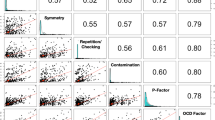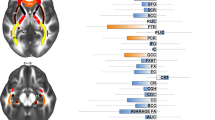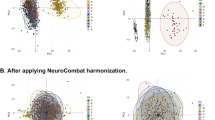Abstract
Obsessive-compulsive disorder (OCD) is a prevalent and often severely disabling illness with onset generally in childhood or adolescence. Although white matter deficits have been implicated in the neurobiology of OCD, few studies have been conducted in pediatric patients when the brain is still developing and have examined their functional correlates. In this study, 23 pediatric OCD patients and 23 healthy volunteers, between the ages of 9 and 17 years, matched for sex, age, handedness, and IQ, received a diffusion tensor imaging exam on a 3T GE system and a brief neuropsychological battery tapping executive functions. Patient symptom severity was assessed using the Children's Yale-Brown Obsessive-Compulsive Scale (CY-BOCS). Patients with OCD exhibited significantly greater fractional anisotropy compared to matched controls in the left dorsal cingulum bundle, splenium of the corpus callosum, right corticospinal tract, and left inferior fronto-occipital fasciculus. There were no regions of significantly lower fractional anisotropy in patients compared to controls. Higher fractional anisotropy in the splenium was significantly correlated with greater obsession severity on the CY-BOCS in the subgroup of psychotropic drug-naïve patients. Among patients, there was a significant association between greater fractional anisotropy in the dorsal cingulum bundle and better performance on measures of response inhibition and cognitive control. The overall findings suggest a pattern of greater directional coherence of white matter tracts in OCD very early in the course of illness, which may serve a compensatory mechanism, at least for response inhibition functions typically subserved by the cingulum bundle.
Similar content being viewed by others
Log in or create a free account to read this content
Gain free access to this article, as well as selected content from this journal and more on nature.com
or
References
Abramovitch A, Dar R, Schweiger A, Hermesh H (2011). Neuropsychological impairments and their association with obsessive-compulsive symptom severity in obsessive-compulsive disorder. Arch Clin Neuropsychol 26: 364–376.
Adler CM, McDonough-Ryan P, Sax KW, Holland SK, Arndt S, Strakowski SM (2000). fMRI of neuronal activation with symptom provocation in unmedicated patients with obsessive compulsive disorder. J Psychiatr Res 34: 317–324.
American Psychiatric Association (1994). Diagnostic and Statistical Manual of Mental Disorders, 4th edn. American Psychiatric Association: Washington, DC.
Bannon S, Gonsalvez CJ, Croft RJ, Boyce PM (2002). Response inhibition deficits in obsessive-compulsive disorder. Psychiatry Res 110: 165–174.
Beers SR, Rosenberg DR, Dick EL, Williams T, O’Hearn KM, Birmaher B et al (1999). Neuropsychological study of frontal lobe function in psychotropic-naive children with obsessive-compulsive disorder. Am J Psychiatry 156: 777–779.
Bora E, Harrison BJ, Fornito A, Cocchi L, Pujol J, Fontenelle LF et al (2011). White matter microstructure in patients with obsessive-compulsive disorder. J Psychiatry Neurosci 36: 42–46.
Breiter HC, Rauch SL, Kwong KK, Baker JR, Weisskoff RM, Kennedy DN et al (1996). Functional magnetic resonance imaging of symptom provocation in obsessive-compulsive disorder. Arch Gen Psychiatry 53: 595–606.
Bush G, Luu P, Posner MI (2000). Cognitive and emotional influences in anterior cingulate cortex. Trends Cogn Sci 4: 215–222.
Cannistraro PA, Makris N, Howard JD, Wedig MM, Hodge SM, Wilhelm S et al (2007). A diffusion tensor imaging study of white matter in obsessive-compulsive disorder. Depress Anxiety 24: 440–446.
Carmona S, Bassas N, Rovira M, Gispert JD, Soliva JC, Prado M et al (2007). Pediatric OCD structural brain deficits in conflict monitoring circuits: a voxel-based morphometry study. Neurosci Lett 421: 218–223.
Chamberlain SR, Fineberg NA, Blackwell AD, Robbins TW, Sahakian BJ (2006). Motor inhibition and cognitive flexibility in obsessive-compulsive disorder and trichotillomania. Am J Psychiatry 163: 1282–1284.
Ciesielski KT, Rowland LM, Harris RJ, Kerwin AA, Reeve A, Knight JE (2011). Increased anterior brain activation to correct responses on high-conflict Stroop task in obsessive-compulsive disorder. Clin Neurophysiol 122: 107–113.
de Lacoste MC, Kirkpatrick JB, Ross ED (1985). Topography of the human corpus callosum. J Neuropathol Exp Neurol 44: 578–591.
den Braber A, van’t Ent D, Boomsma DI, Cath DC, Veltman DJ, Thompson PM et al (2011). White matter differences in monozygotic twins discordant or concordant for obsessive-compulsive symptoms: a combined diffusion tensor imaging/voxel-based morphometry study. Biol Psychiatry 70: 969–977.
Fitzgerald KD, Stern ER, Angstadt M, Nicholson-Muth KC, Maynor MR, Welsh RC et al (2010). Altered function and connectivity of the medial frontal cortex in pediatric obsessive-compulsive disorder. Biol Psychiatry 68: 1039–1047.
Fontenelle LF, Bramati IE, Moll J, Medlowitcz MV, de Oliveira-Souza R, Tovar-Moll F (2011). White matter changes in ocd revealed by diffusion tensor imaging. CNS Spectr 16: (e-pub ahead of print).
Fontenelle LF, Harrison BJ, Yucel M, Pujol J, Fujiwara H, Pantelis C (2009). Is there evidence of brain white-matter abnormalities in obsessive-compulsive disorder? A narrative review. Top Magn Reson Imag 20: 291–298.
Friston KJ (1997). Testing for anatomical specified regional effects. Hum Brain Mapp 5: 133–136.
Garibotto V, Scifo P, Gorini A, Alonso CR, Brambati S, Bellodi L et al (2010). Disorganization of anatomical connectivity in obsessive compulsive disorder: a multi-parameter diffusion tensor imaging study in a subpopulation of patients. Neurobiol Dis 37: 468–476.
Harrison BJ, Soriano-Mas C, Pujol J, Ortiz H, Lopez-Sola M, Hernandez-Ribas R et al (2009). Altered corticostriatal functional connectivity in obsessive-compulsive disorder. Arch Gen Psychiatry 66: 1189–1200.
Huyser C, Veltman DJ, de Haan E, Boer F (2009). Paediatric obsessive-compulsive disorder, a neurodevelopmental disorder? Evidence from neuroimaging. Neurosci Biobehav Rev 33: 818–830.
Huyser C, Veltman DJ, Wolters LH, de Haan E, Boer F (2010). Functional magnetic resonance imaging during planning before and after cognitive–behavioral therapy in pediatric obsessive-compulsive disorder. J Am Acad Child Adolesc Psychiatry 49: 1238–1248, 1231–1235.
Insel TR (1992). Toward a neuroanatomy of obsessive-compulsive disorder. Arch Gen Psychiatry 49: 739–744.
Jarbo K, Verstynen T, Schneider W (2011). In vivo quantification of global connectivity in the human corpus callosum. NeuroImage 59: 1988–1996.
Jenkinson M, Bannister P, Brady M, Smith S (2002). Improved optimization for the robust and accurate linear registration and motion correction of brain images. NeuroImage 17: 825–841.
Kaufman J, Birmaher B, Brent D, Rao U, Flynn C, Moreci P et al (1997). Schedule for affective disorders and schizophrenia for school-age children-present and lifetime version (K-SADS-PL): initial reliability and validity data. J Am Acad Child Adolesc Psychiatry 36: 980–988.
Kiejna A, Rymaszewska J, Kantorska-Janiec M, Tokarski W (2002). Epidemiology of obsessive-compulsive disorder. Psychiatr Pol 36: 539–548.
Koch K, Wagner G, Schachtzabel C, Schultz CC, Straube T, Gullmar D et al (2012). White matter structure and symptom dimensions in obsessive-compulsive disorder. J Psychiatr Res 46: 264–270.
Krishna R, Udupa S, George CM, Kumar KJ, Viswanath B, Kandavel T et al (2011). Neuropsychological performance in OCD: a study in medication-naive patients. Prog Neuropsychopharmacol Biol Psychiatry 35: 1969–1976.
Li F, Huang X, Yang Y, Li B, Wu Q, Zhang T et al (2011). Microstructural brain abnormalities in patients with obsessive-compulsive disorder: diffusion-tensor MR imaging study at 3.0 T. Radiology 260: 216–223.
Mac Master FP, Keshavan MS, Dick EL, Rosenberg DR (1999). Corpus callosal signal intensity in treatment-naive pediatric obsessive compulsive disorders. Prog Neuropsychopharmacol Biol Psychiatry 23: 601–612.
Maia TV, Cooney RE, Peterson BS (2008). The neural bases of obsessive-compulsive disorder in children and adults. Dev Psychopathol 20: 1251–1283.
Menzies L, Williams GB, Chamberlain SR, Ooi C, Fineberg N, Suckling J et al (2008). White matter abnormalities in patients with obsessive-compulsive disorder and their first-degree relatives. Am J Psychiatry 165: 1308–1315.
Nakamae T, Narumoto J, Sakai Y, Nishida S, Yamada K, Nishimura T et al (2011). Diffusion tensor imaging and tract-based spatial statistics in obsessive-compulsive disorder. J Psychiatr Res 45: 687–690.
Pandya DN, Karol EA, Heilbronn D (1971). The topographical distribution of interhemispheric projections in the corpus callosum of the rhesus monkey. Brain Res 32: 31–43.
Park HY, Park JS, Kim SH, Jang JH, Jung WH, Choi JS et al (2011). Midsagittal structural differences and sexual dimorphism of the corpus callosum in obsessive-compulsive disorder. Psychiatry Res 192: 147–153.
Pauls DL, Alsobrook II JP, Goodman W, Rasmussen S, Leckman JF (1995). A family study of obsessive-compulsive disorder. Am J Psychiatry 152: 76–84.
Penades R, Catalan R, Rubia K, Andres S, Salamero M, Gasto C (2007). Impaired response inhibition in obsessive compulsive disorder. Eur Psychiatry 22: 404–410.
Putnam MC, Steven MS, Doron KW, Riggall AC, Gazzaniga MS (2010). Cortical projection topography of the human splenium: hemispheric asymmetry and individual differences. J Cogn Neurosci 22: 1662–1669.
Radua J, Mataix-Cols D (2009). Voxel-wise meta-analysis of grey matter changes in obsessive-compulsive disorder. Br J Psychiatry 195: 393–402.
Rauch SL, Jenike MA, Alpert NM, Baer L, Breiter HC, Savage CR et al (1994). Regional cerebral blood flow measured during symptom provocation in obsessive-compulsive disorder using oxygen 15-labeled carbon dioxide and positron emission tomography. Arch Gen Psychiatry 51: 62–70.
Robinson D, Wu H, Munne RA, Ashtari M, Alvir JM, Lerner G et al (1995). Reduced caudate nucleus volume in obsessive-compulsive disorder. Arch Gen Psychiatry 52: 393–398.
Rosenberg DR, Keshavan MS (1998). A.E. Bennett Research Award. Toward a neurodevelopmental model of obsessive-compulsive disorder. Biol Psychiatry 43: 623–640.
Rosenberg DR, Keshavan MS, Dick EL, Bagwell WW, MacMaster FP, Birmaher B (1997a). Corpus callosal morphology in treatment-naive pediatric obsessive compulsive disorder. Prog Neuropsychopharmacol Biol Psychiatry 21: 1269–1283.
Rosenberg DR, Keshavan MS, O’Hearn KM, Dick EL, Bagwell WW, Seymour AB et al (1997b). Fronto-striatal measurement of treatment-naïve pediatric obsessive compulsive disorder. Arch Gen Psychiatry 54: 824–830.
Rotge JY, Guehl D, Dilharreguy B, Tignol J, Bioulac B, Allard M et al (2009). Meta-analysis of brain volume changes in obsessive-compulsive disorder. Biol Psychiatry 65: 75–83.
Saito Y, Nobuhara K, Okugawa G, Takase K, Sugimoto T, Horiuchi M et al (2008). Corpus callosum in patients with obsessive-compulsive disorder: diffusion-tensor imaging study. Radiology 246: 536–542.
Scahill L, Riddle MA, McSwiggin-Hardin M, Ort SI, King RA, Goodman WK et al (1997). Children's Yale-Brown Obsessive Compulsive Scale: reliability and validity. J Am Acad Child Adolesc Psychiatry 36: 844–852.
Smith SM (2002). Fast robust automated brain extraction. Hum Brain Mapp 17: 143–155.
Smith SM, Jenkinson M, Johansen-Berg H, Rueckert D, Nichols TE, Mackay CE et al (2006). Tract-based spatial statistics: voxelwise analysis of multi-subject diffusion data. NeuroImage 31: 1487–1505.
Song SK, Sun SW, Ju WK, Lin SJ, Cross AH, Neufeld AH (2003). Diffusion tensor imaging detects and differentiates axon and myelin degeneration in mouse optic nerve after retinal ischemia. NeuroImage 20: 1714–1722.
Song SK, Sun SW, Ramsbottom MJ, Chang C, Russell J, Cross AH (2002). Dysmyelination revealed through MRI as increased radial (but unchanged axial) diffusion of water. NeuroImage 17: 1429–1436.
Song SK, Yoshino J, Le TQ, Lin SJ, Sun SW, Cross AH et al (2005). Demyelination increases radial diffusivity in corpus callosum of mouse brain. NeuroImage 26: 132–140.
Swedo SE, Schapiro MB, Grady CL, Cheslow DL, Leonard HL, Kumar A et al (1989). Cerebral glucose metabolism in childhood-onset obsessive-compulsive disorder. Arch Gen Psychiatry 46: 518–523.
Szeszko PR, Ardekani BA, Ashtari M, Malhotra AK, Robinson DG, Bilder RM et al (2005). White matter abnormalities in obsessive-compulsive disorder: a diffusion tensor imaging study. Arch Gen Psychiatry 62: 782–790.
Szeszko PR, MacMillan S, McMeniman M, Chen S, Baribault K, Lim KO et al (2004). Brain structural abnormalities in psychotropic drug-naïve pediatric patients with obsessive-compulsive disorder. Am J Psychiatry 161: 1049–1056.
Szeszko PR, Robinson D, Alvir JM, Bilder RM, Lencz T, Ashtari M et al (1999). Orbital frontal reductions in obsessive-compulsive disorder. Arch Gen Psychiatry 56: 913–919.
Uluğ A, Argyelan M, Eidelberg D (2009). Early registration of diffusion tensor images for group tractography (abstract). Magma 22 (Suppl 1): 107.
van den Heuvel OA, Veltman DJ, Groenewegen HJ, Cath DC, van Balkom AJ, van Hartskamp J et al (2005). Frontal–striatal dysfunction during planning in obsessive-compulsive disorder. Arch Gen Psychiatry 62: 301–309.
Vo A, Argyelen M, Eidelberg D, Uluğ AM (2012). Early registration of diffusion tensor images for group tractography of dystonia patients. J Magnet Reson Imag (in press).
Wakana S, Jiang H, Nagae-Poetscher LM, van Zijl PC, Mori S (2004). Fiber tract-based atlas of human white matter anatomy. Radiology 230: 77–87.
Yoo SY, Jang JH, Shin YW, Kim DJ, Park HJ, Moon WJ et al (2007). White matter abnormalities in drug-naive patients with obsessive-compulsive disorder: a diffusion tensor study before and after citalopram treatment. Acta Psychiatr Scand 116: 211–219.
Zarei M, Mataix-Cols D, Heyman I, Hough M, Doherty J, Burge L et al (2011). Changes in gray matter volume and white matter microstructure in adolescents with obsessive-compulsive disorder. Biol Psychiatry 70: 1083–1090.
Acknowledgements
This work was funded by the International Obsessive Compulsive Disorder Foundation, National Institute of Mental Health (R01 MH076995), an Advanced Center for Intervention and Services Research (P30 MH090590), and NSLIJ General Clinical Research Center (M01 RR018535). We thank the children and parents who participated in this study.
Author information
Authors and Affiliations
Corresponding author
Ethics declarations
Competing interests
Dr Gruner, Dr Vo, Dr Ikuta, Dr Mahon, Dr Peters, Dr Malhotra, Dr, Uluğ, and Dr Szeszko declare no conflicts of interest. Dr Gruner, Dr Vo, Dr Ikuta, Ms,. Mahon, Dr Peters, and Dr Uluğ declare that, except for income received from their primary employers, no financial support or compensation has been received from any individual or corporate entity over the past 3 years for research or professional service and there are no personal financial holdings that could be perceived as constituting a potential conflict of interest. Dr Szeszko has received compensation from Boehringer Ingelheim. Dr Malhotra has received compensation from Eli Lilly, Schering-Plough/Merck, Sunovion Pharmaceuticals, Genomind, and Shire.
Rights and permissions
About this article
Cite this article
Gruner, P., Vo, A., Ikuta, T. et al. White Matter Abnormalities in Pediatric Obsessive-Compulsive Disorder. Neuropsychopharmacol 37, 2730–2739 (2012). https://doi.org/10.1038/npp.2012.138
Received:
Revised:
Accepted:
Published:
Issue date:
DOI: https://doi.org/10.1038/npp.2012.138
Keywords
This article is cited by
-
White matter abnormalities in paediatric obsessive–compulsive disorder: a systematic review of diffusion tensor imaging studies
Brain Imaging and Behavior (2023)
-
Associations Between Preterm Birth, Inhibitory Control-Implicated Brain Regions and Tracts, and Inhibitory Control Task Performance in Children: Consideration of Socioeconomic Context
Child Psychiatry & Human Development (2023)
-
The prefrontal cortex and OCD
Neuropsychopharmacology (2022)
-
White matter microstructure and its relation to clinical features of obsessive–compulsive disorder: findings from the ENIGMA OCD Working Group
Translational Psychiatry (2021)
-
Reduced focal fiber collinearity in the cingulum bundle in adults with obsessive-compulsive disorder
Neuropsychopharmacology (2019)



